T.S.M.V. Manoora
1935 to 1962 and she had three names thereafter
Firefox and some iPad’s or iPhone’s, etc are not
suitable
Use Google Chrome
for this web page to load perfectly!

Click
the logo above to reach the ssMaritime FrontPage for Ships of the Month &
News Updates
With
Reuben
Goossens
Maritime Historian, Cruise‘n’Ship Reviewer, Author &
Lecturer
Please Note: All ssmaritime as well as my other related
maritime & cruise sites are 100% non-commercial and privately owned sites.
Be assured that I am NOT associated with any shipping or cruise companies or
agencies or any other organisations! The author has been in the passenger
shipping industry since May 1960, but although retired and unwell, I
occasionally attempt to write an article now and then, in order to bring
enjoyment and pleasure to ship enthusiasts past passengers and crew.
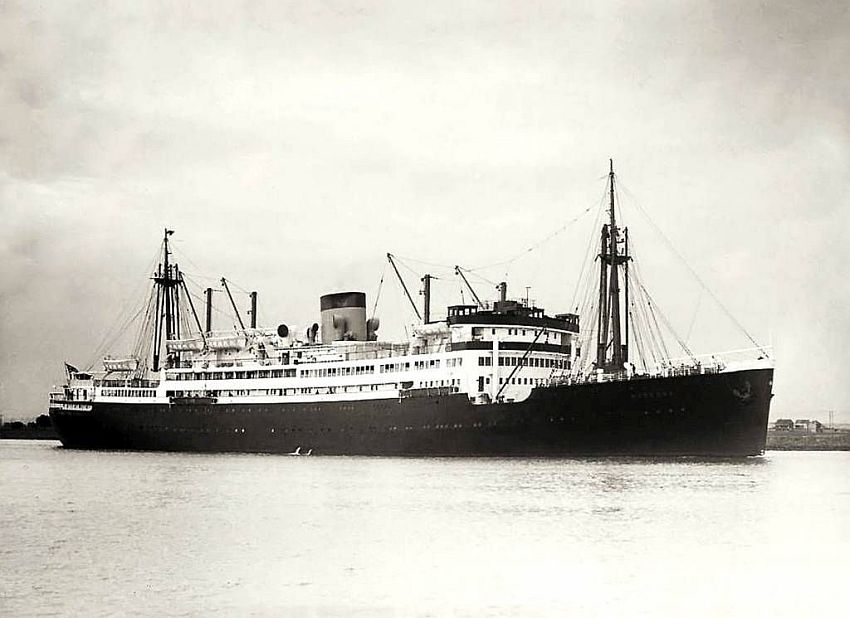
The
magnificent Australian Coastal Liner T.S.M.V. Manoora
Photographs
are from the ssMaritime historic collection - unless stated otherwise
Also
with grateful thanks to the “Australian
War Memorial” (AWM)
Page One
Adelaide Steamship Company
T.S.M.V.
Manoora
H.M.A.S. Manoora & T.S.M.V.
Ambulombo, Affan
Oceana,
Ambulombo
A Three-Page
Feature
Complete
with items of Manoora Memorabilia as well as a complete Deck Plan
This Page also includes a history of the … T.S.M.V.
Manunda
Introduction:
Page One will commence with the history of two
fine Australian Coastal passenger liners the T.S.M.V.
Manunda
of 1929, and the greatest ship of the fleet and the very last Australian
coastal liner in service at the end of her career, the T.S.M.V.
Manoora of 1935. Page Two has a
Passenger story, as well as images of various items of memorabilia, and Page
Three has her Deck Plan.
Enjoy this feature of two great Australian
Ships!
Reuben
Goossens.
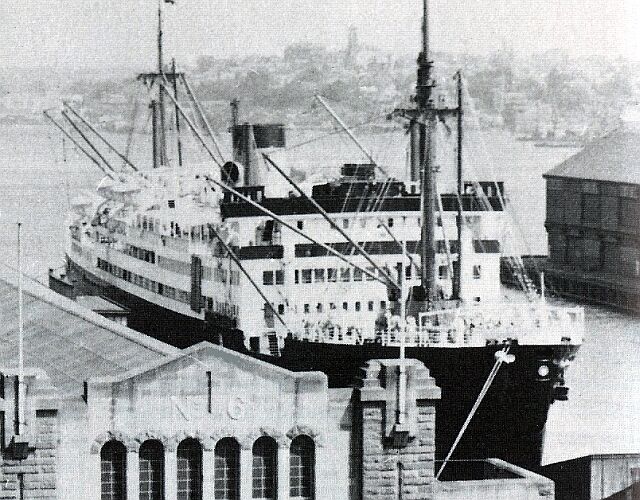
TSMV
Manoora berthed in Sydney
Prior
to World War I the Adelaide Steamship Company operated a number of smaller
coastal passenger-cargo liners, all of which were used for wartime duties.
After the war and with the economy being what is was the company decided to
operate mainly its cargo services with very limited passenger facilities.
1. TSMV Manunda:
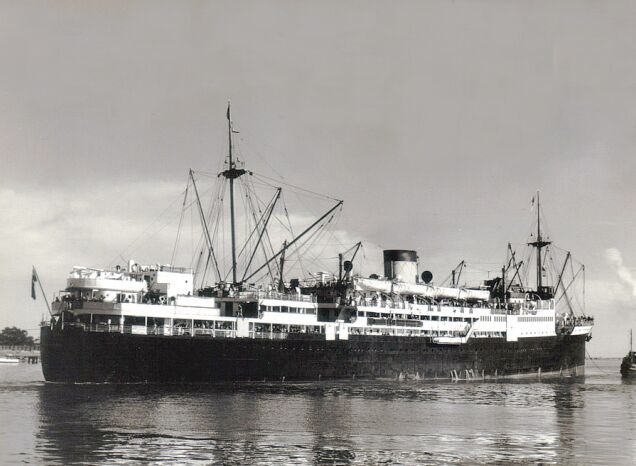
A
delightful stern view of the TSMV Manunda
In 1927 a new 9,119 GRT liner was
ordered, which was to be built by William Beardmore & Co, Dalmuir Scotland
for the Adelaide Steamship Company. This ship was to recommence the
company’s fulltime Australian coastal passenger services. The T.S.M.V.
Manunda
was built and commenced her duties in 1929.
She was the largest ship the company had ever
built and she accommodated 176 First Class and 136 Second Class passengers and
she sailed at a comfortable service speed of 15 knots. Her story
will be continued as this the page continues.
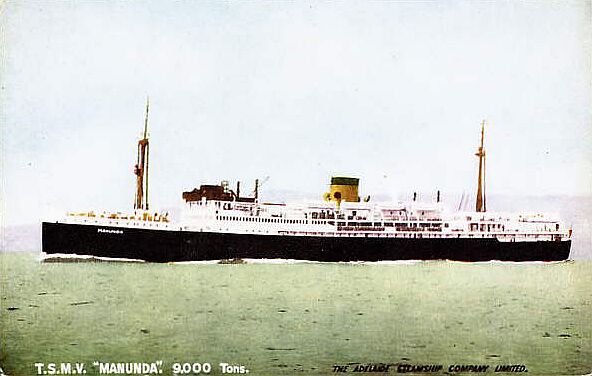
A
colour postcard of the Manunda
2. TSMV
Manoora:
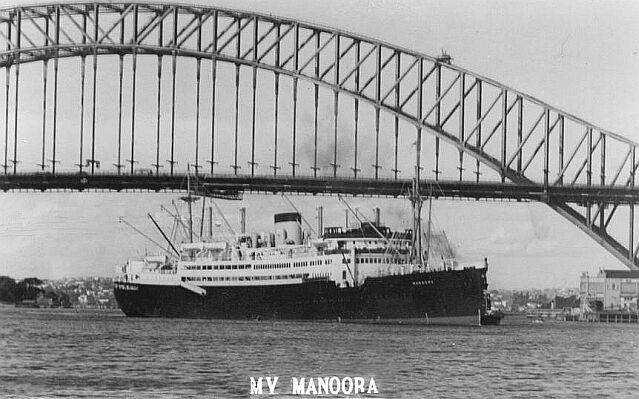
A
wonderful view of the Manoora passing under the Sydney
Harbour
Bridge
– the famed “Coat Hanger”
With
the success of the Manunda, the company decided to build an even larger and
faster ship and thus ordered the TSMV Manoora to be built by Alexander
Stephen & Sons, Glasgow
(Govan), Scotland.
Her first steel plate was laid down in July 1934; her completed hull was
launched relatively quickly on October 25, 1934, and she was fully fitted out
and completed on February 7 1935.
After
her relocation voyage to Australia
she made her maiden Australian coastal voyage from Sydney
to Fremantle (Perth
Western
Australia)
on April 11, 1935. There is no doubt that the Manoora enjoyed a great deal of
success along the Australian coast and she later sailed alongside another famed
Australian liner, the TSMV Kanimbla.
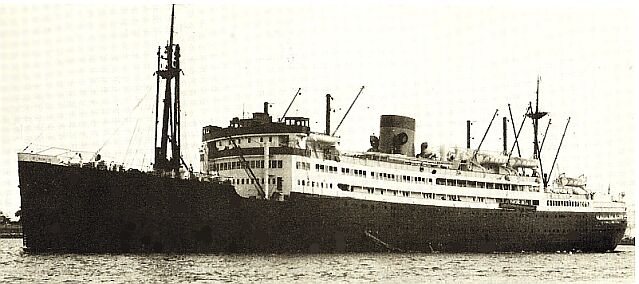
Manoora
is seen entering the Brisbane
River
****************************
Wartime
duties with the Royal Australian Navy
1. HMAS
Manoora:
Sadly war tends to destroy
passenger services but it is very necessary in such difficult times! The Royal
Australian Navy requisitioned the Manoora on October 11, 1939 and she was sent
to Garden
Island
in Sydney
to be refitted for service as an armed merchant cruiser (AMC) and she was
officially commissioned on December 12, 1939. Her complement was drawn almost
entirely from the Royal Australian Navy, including Australian reservists having
a total complement of 345. She was fitted with, 7 x 6-inch guns; 2 x 3-inch
anti-aircraft guns and 2 x Lewis
light machine guns. HMAS Manoora took up patrol duties in the Coral
Sea and in The
Pacific.

HMAS
Manoora seen in her role as an armed merchant cruiser in 1942
Australian
War Memorial (AWM) - Catalogue number P00041.030
Whilst
writing this article, I have been corresponding with brothers Michael
Cooke
(in Australia)
and Martin
Cooke
(an Opera singer in Germany);
whose father James
Cooke
was an original crew member on the TSMV Manoora. He was a chief petty officer /
chief steward. He was in charge of the canteen and responsible for the
hygiene on board.
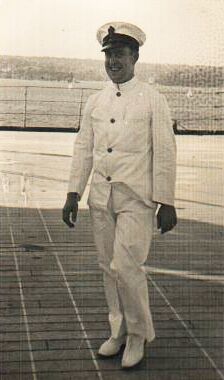
Manoora’s
Chief petty officer James
Cooke
(1939?)
He remained with
the ship throughout the war until she was decommissioned. There is no doubt
that James
saw some terrible battles during those years. The HMAS Manoora was a well
fitted-out ship with her multiple six inch guns as well as numerous two pounder
guns and multiple Bofors similar to a light cruiser, but obviously with an
enlarged superstructure.
The HMAS Manoora was constantly
hounded by Kamikaze aircraft strikes and was also under attack by long range
Japanese shore batteries. She seemed to escape each time without damage.
However she inflicted considerable damage on other ships.
The 9,870-ton Italian (Lloyd Triestino) liner
M.S. Romolo departed Brisbane on 5 June, knowing that her sister ship the MS
Remo had already been impounded at Fremantle, as Italy had declared loyalty to
Nazi Germany. For that reason the captain of the MS Romolo decided to make a
run for it and headed for Cape
York Peninsula.
Although HMAS Manoora had originally been ordered to shadow her, for some
reason she had been called off, she was again called upon to locate and stop
the MS Romolo. HMAS Manoora located the MS Romolo approximately 220 miles south
west of Nauru.
The captain of the MS Romolo ordered the crew to scuttle her and abandon ship.
HMAS Manoora finished the job using her six inch guns and sunk her.
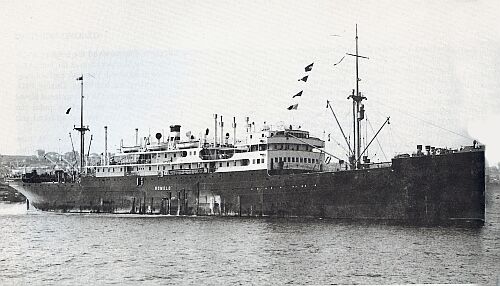
The
Italian Liner MS Romolo
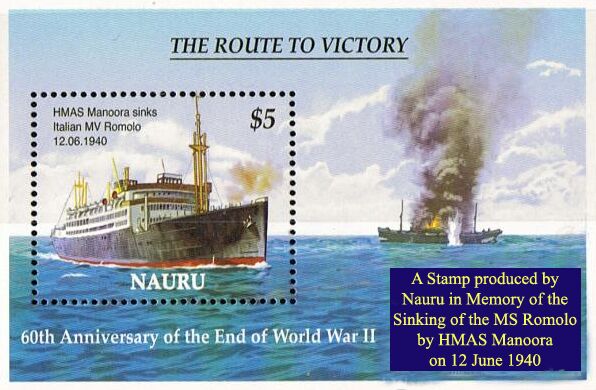
HMAS Manoora returned to Sydney
on September 30, 1942 to be converted to a Landing Ship, Infantry (LSI), and
was completed by February 2, 1943. She was officially reclassified on that
date. For this role she had been fitted with 1 x 6-inch gun, which was later
replaced by 2 x 4-inch guns, 2 x 3-inch anti-aircraft guns, 8 x 20mm Oerlikon
anti-aircraft guns. She also carried one Seagull V aircraft that was housed
forward of her funnel. Added later were 6 x 40mm Bofors anti-aircraft guns.
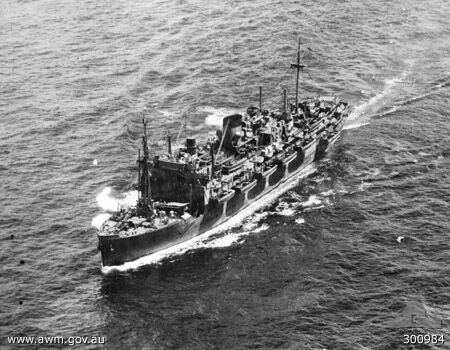
Landing
Ship, Infantry (LSI) HMAS Manoora seen in 1943
AWM
catalogue number 300984
As an LSI the HMAS
Manoora had a capacity to carry 1,230 troops. She saw a great deal of action in
an allied push in the north, as well as in the Lingayan
Gulf,
Tarakan, Labuan
and Balikpan. Thereafter she also transported troops from India
and the Dutch East Indies (Indonesia)
to Australia.
With the HMAS Manunda back in action, the HMAS Manoora was used to bring back
repatriated prisoners of war from Singapore.
Stoker Richard ‘Laurie’ Johnson,
RAN, 1942-1945, served on HMAS Manoora from mid 1944 to late 1945, having been
involved in the Allied amphibious landings at Philippines, Luzon, Borneo, and
the occupation of Rabaul. It was there the crew of the HMAS Manoora witnessed the
formal surrender of the Japanese.
Richard
‘Laurie’
Johnson
currently lives in Newcastle
Australia
and is eighty-three years of age (at the time of writing)!
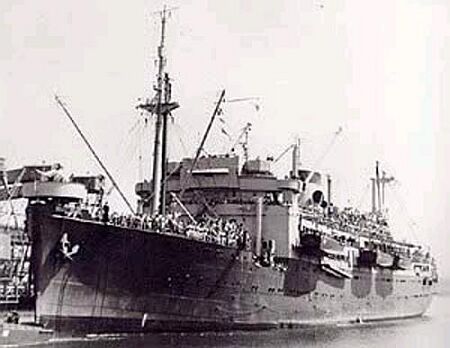
Another
photo of the HMAS Manoora (LSI)
(Source
unknown)

HMAS
Manoora seen in action during the latter end of the war
Note
her camouflage livery
Photograph
was provided by Mr.
Alan
Burns
****************************
2. HMAS Manunda:
The TSMV Manunda was requisitioned in
September 1939 and she was converted into a fulltime hospital ship. HMAS
Manunda was officially commissioned on May 25 1940 after which she operated
four voyages to the Middle East to bring back wounded troops to Australia.
On February 19, 1942 during a Japanese bombing
raid whilst the ship was at anchor in Darwin
harbour, a bomb hit right through the music room skylight, which exploded down
on C deck tragically killing 12 and injuring 157 others. The next day she
sailed for Fremantle with 266 patients. Whilst in Fremantle she was repaired
and made ready for her next chapter in the war effort.
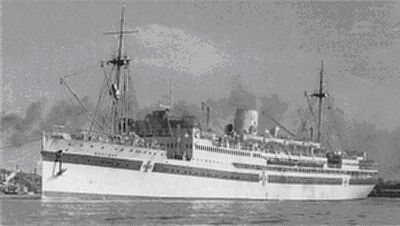
Hospital Ship HMAS Manunda
From Fremantle she was sent to Milne
Bay
in Papua where she acted as a floating hospital for the Allied forces stationed
there.
In addition HMAS Manunda made a number of
voyages from Milne
Bay
to Brisbane
and Sydney
transporting wounded troops. As the war continued she was relocated as required
and followed the Allied forces to the various islands around the Pacific.
During the war she carried well over 30,000 casualties to safety.
Manunda’s final wartime voyage was to New
Zealand
transporting civilian passengers.
After the Japanese surrendered HMAS Manunda
was dispatched to Singapore
to repatriate Australian soldiers and others who had been imprisoned in the
infamous Changi Prison.
****************************
Return to civil duties:
Having served her country with great honour,
HMAS Manoora was decommissioned on December 6, 1947. Whilst the TSMV Manunda
received an extensive, 18 months, refit in Melbourne
and returned to service on April 2,
1948. For some reason the Adelaide Steamship Co decided to give
the TSMV Manoora a twelve month lay-up and then give her an extensive refit.
She was not returned to her regular services until August 31, 1949.
Together the TSMV Manunda and the TSMV Manoora
sailed the vast Australian coast as did the somewhat more luxurious TSMV
Kanimbla. These services lasted until 1956 when the company decided to reduce
its passenger operations, due to the competition taking place in the sky, with
domestic air fares becoming more and more affordable.
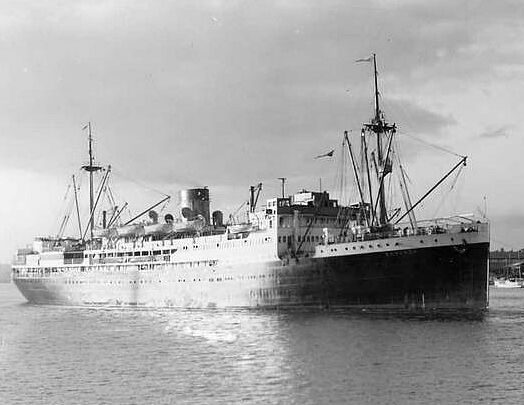
TSMV Manunda sailing up the Brisbane
River
- Seen towards the end of her career
The
final days for TSMV Manunda:
Sadly in September 1956 TSMV Manunda was
withdrawn from service and placed on the market. She was sold to
“Okadagumi Shipping Ltd” of Japan.
She departed Sydney
for the last time named the Hakone
Maru
on October 4, 1956. However the company’s plans for her did not eventuate
and she was resold to be broken up the following year in Japan.
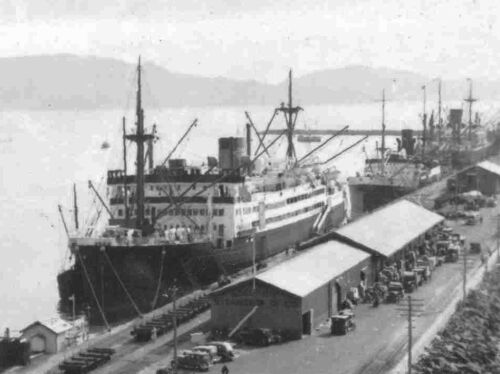
TSMV Manoora seen in Townsville
The
photograph of the Manoora above was provided by Peter
Johnson
- Stoker Laurie’s son
TSMV
Manoora continued to sail on but passenger numbers were rapidly declining. Much
the same as it was with all liners around the world. With air travel becoming
the popular mode of city to city travel, in 1959 Adelaide Steamship Company
changed their operations and commenced a series of South Pacific cruises. She
did this with considerable success, although this was not deemed to be a long
term solution. Thereafter she returned to coastal duties, making the TSMV
Manoora the very last Australian coastal liner to do so!
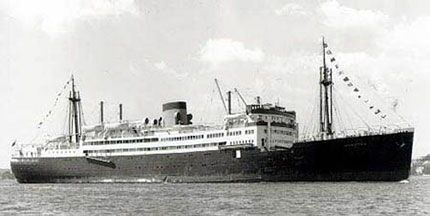
The Manoora departs Australia
on a cruise looking a delight being fully dressed
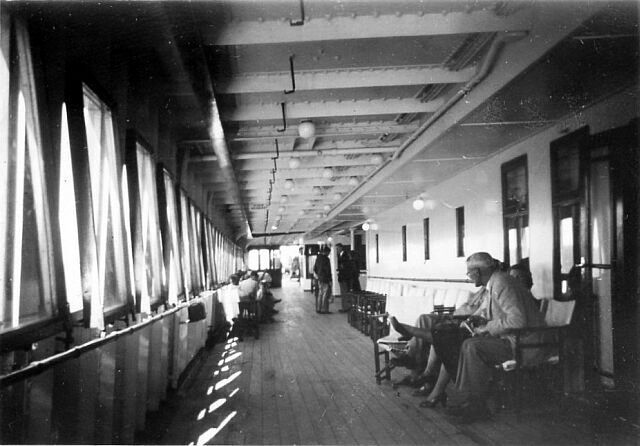
Passengers seen relaxing on the glass
enclosed Promenade Deck during one of her voyages
Sent
in by a supporter, but sadly details have been lost, Please see my photo notes
at bottom of page!
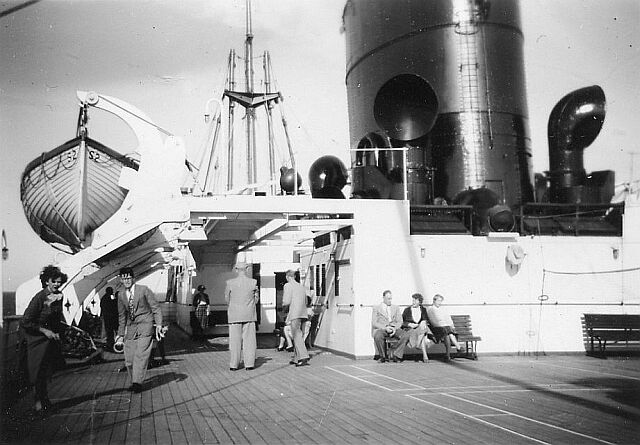
Whilst sailing in sunny Queensland
it was the perfect time to have fun and enjoy the sun and a few games up on
Sports deck
Sent in
by a supporter, but sadly details have been lost, Please see my photo notes at
bottom of page!
T.S.M.V.
Manoora
Specifications:
Builders: Alexander
Stephen & Sons, Glasgow
(Govan). Scotland.
Yard: 540.
Launched; October 25, 1934.
Tonnage: 10,856 GRT (Gross Registered Tonnage).
Length: 150 m / 482 ft.
Beam: 20.19 m / 66.3 ft.
Draught: 7.3 m / 24 ft.
Engines: Burmeister & Wain Geared
Diesels.
Screws: Twin – 8,830 BHP.
Speed: 16 knots (Max 18.5).
Passengers: 260 First Class.
100 Second
Class.
****************************
The end of Australian services
for the Manoora:
Sadly in 1961,
the Adelaide Steamship decided to place their
beloved TSMV Manoora on the market and she was purchased by the Indonesian
Government, who renamed TSMV Ambulombo before she departed Melbourne
with an Indonesian crew for the last time on 26 August, 1961.
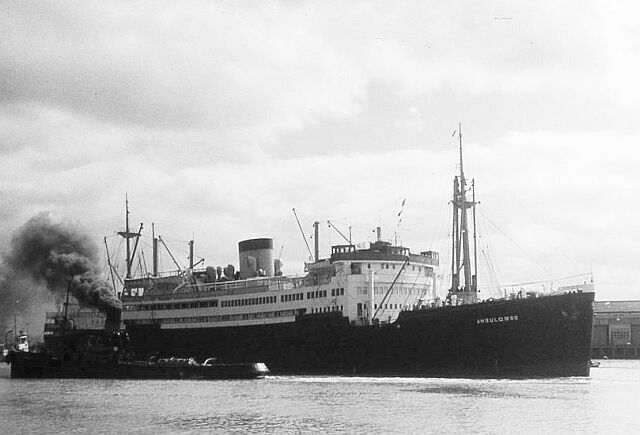
The
ex Manoora is seen here departing Melbourne
in August 1961
TSMV
Ambulombo having been refitted as a pilgrim ship, she commenced
her duties carrying pilgrims to Mecca.
She undertook many voyages in addition she also operated some cruises.
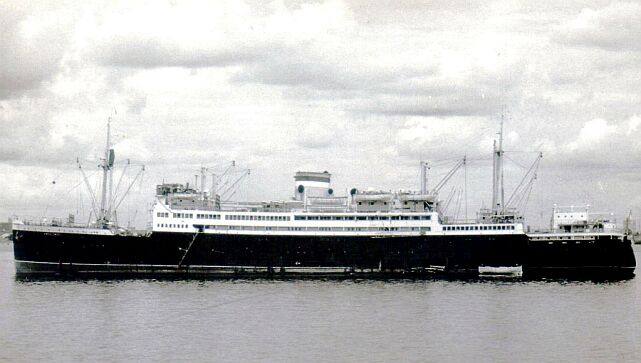
She
is seen here as the TSMV Ambulombo
In
1965 she was sold to another Indonesian company, PT
Affan Raya, who renamed her TSMV Affan
Oceana and she continued in her
previous role as a pilgrim ship.
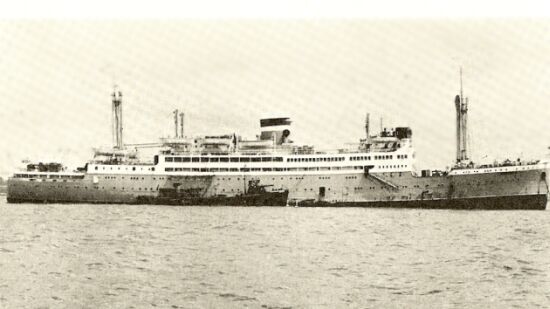
This
image is after she became the TSMV Affan Oceana
In
1966 she was sold to PT
Perusahaan Pelajaran who restored
her to her first Indonesian name Ambulombo and she resumed her regular pilgrim
duties. However, from 1970 she was laid up until she finally was sold to
Taiwanese ship beakers in 1972.
However, whilst under tow from Djakarta to
Kaohsiung, by the Japanese tug Fujisan Maru where she was to be broken up, TSMV
Ambulombo sprang a leak and duly sank off Luzon on November 18, 1972, and she
lay’s in position 18°19’ N-120°34’ E. We could call this in
maritime terms, “a dignified end for a great lady”, which is better
than men crawling all over her and with countless blow torches cutting her into
little pieces for scrap metal and razor blades, etc!
In Conclusion:
The Manoora
and Manunda covered great distances and transported
countless thousands of people around the coast of Australia.
I have not included a complete wartime history on these ships, for there are
other sites that will have much more. This page has been created for you to
relive the days when Australia
had some damn fine Coastal Liners and they were the days when we went to the
wharves and looked at these ships and marvelled at them with great pride. Australia
once had a proud maritime history, which is all but a memory. I hope this page
will bring back some of the magic of yesteryear - Bon Voyage!
A special thank you, to: Michael
and
Martin
Cooke for
providing
information
and
an
image
of
their
father
James
Cooke who
served
on
the
HMAS
Manoora before
and
during
the
war.
Also, thank you Peter
Johnson,
Stoker Laurie’s son for your contributions
and Keith
Fry
(Perth
Australia)
for editing this article! For photo credits, see below.
T.S.M.V
Manoora
~ INDEX:
Page
One … The
Ships history page. (This Page).
Page
Two … Mr
& Mrs
Dwyer
sail on the
Manoora
in MAY 1958 & the Memorabilia Page.
Page
Three … Ships Deck Plan provided by Mr.
Jack
Dwyer.
“Blue
Water Liners sailing to the distant shores.
I watched them come, I watched them go and I watched them die.”
****************************
Return
to the ssMaritime MAIN INDEX
ssMaritime.com &
ssMaritime.net
Where you will discover over
1,350 Classic Liners & the
1914 built MV Doulos
Story
The
Author has been in Passenger Shipping & the Cruise Industry for a good 60
years
Please Note: ssmaritime and associated sites are 100% non-commercial and the
author seeks no funding or favours of any shape or form, never have and never
will!
Photographs on ssmaritime and associate
pages are: by the author or from the
author’s private collection. In addition there are some images that have
been provided by Shipping Companies and private photographers or collectors.
Credit is given to all contributors. However, there are some photographs
provided to me without details regarding the photographer/owner concerned. I
hereby invite if owners of these images would be so kind to make them-selves
known to me (my email address may be found on www.ssmaritime.com only), in order that due credit may be given.
This notice covers all pages: although, and I have done my best to ensure that all photographs are
duly credited and that this notice is displaced on each page, that is, when a
page is updated!
ssMaritime
is owned & © Copyright by Reuben
Goossens
- All Rights Reserved






















